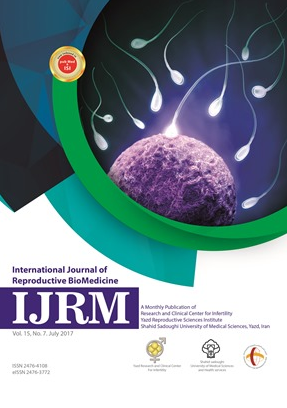
International Journal of Reproductive BioMedicine
ISSN: 2476-3772
The latest discoveries in all areas of reproduction and reproductive technology.
The categorization of opaque pathologies outside of contrast media in hysterosalpingography which facilitate interpretation: A pictorial review
Published date: May 12 2024
Journal Title: International Journal of Reproductive BioMedicine
Issue title: International Journal of Reproductive BioMedicine (IJRM): Volume 22, Issue No. 3
Pages: 191 - 202
Authors:
Abstract:
Hysterosalpingography (HSG) is a practical and reliable imaging method to evaluate the cervical canal, uterine isthmus, uterine cavity, and fallopian tubes. Using HSG, opaque pathologies outside of contrast media can be detected as well as pathologies of uterus and fallopian tubes. We aim to present and categorize some uncommon and interesting abnormal findings that are located outside of the contrast areas in HSG. This is a pictorial review that depicts various types of HSG images that include opaque pathologies outside of the contrast areas. Images have been extracted from valuable archives collected over 50 yr by professor Shahrzad. A plain pelvic film contains soft tissues of the pelvis, bony structures, artifacts, or foreign bodies. Categorization might easily help the radiologist to interpret the HSG cliché. Opaque pathologies outside of contrast area in HSG can be categorized into 2 groups: “Pelvic Tissue Related” and “Foreign Bodies”. Pelvic tissue abnormalities might have a gynecologic or nongynecologic source. Foreign bodies can be located in the pelvis or outside of the body. HSG is a reliable and inexpensive procedure. Familiarity with the pathologies of pelvic tissues and the accurate interpretation of HSG images are important.
Key words: Hysterosalpingography, Opaque, Abnormalities, Uterine, Fallopian tubes.
References:
[1] Luczynska E, Zbigniew K. Diagnostic imaging in gynecology. Ginekol Pol 2022; 93: 63–69.
[2] Bau?ic A, Coroleuca C, Coroleuca C, Comanda?u D, Matasariu R, Manu A, et al. Transvaginal ultrasound vs. magnetic resonance imaging (MRI) value in endometriosis diagnosis. Diagnostics 2022; 12: 1767.
[3] Gündüz R, Agaçayak E, Okutucu G, Karuserci ÖK, Peker N, Çetinçakmak MG, et al. Hysterosalpingography: A potential alternative to laparoscopy in the evaluation of tubal obstruction in infertile patients? Afr Health Sci 2021; 21: 373–378.
[4] Panda SR, Kalpana BJC. The diagnostic value of hysterosalpingography and hysterolaparoscopy for evaluating uterine cavity and tubal patency in infertile patients. Cureus 2021; 13: e12526.
[5] Martí-Bonmatí L. Hysterosalpingography and fertility: A technical relationship. Fertil Steril 2018; 110: 642.
[6] Shaaban AM, Rezvani M, Olpin JD, Kennedy AM, Gaballah AH, Foster BR, et al. Nongynecologic findings seen at pelvic US. Radiographics 2017; 37: 2045–2062.
[7] Zulfiqar M, Shetty A, Tsai R, Gagnon M-H, Balfe DM, Mellnick VM. Diagnostic approach to benign and malignant calcifications in the abdomen and pelvis. Radiographics 2020; 40: 731–753.
[8] Heursen EM, González Partida MD, Paz Expósito J, Navarro Díaz F. Osteomesopyknosis-a benign axial hyperostosis that can mimic metastatic disease. Skeletal Radiol 2016; 45: 141–146.
[9] Ahmadi F, Hosseini F, Javam M, Pahlavan F. Hysterosalpingography findings of leiomyomas and how they look in artistic eyes: New diagnostic signs. Br J Radiol 2021; 94: 20200019.
[10] Taborda F, Fernandes B, Lobão MJ. Calcified uterine myoma: An infrequent radiologic finding. Lusiadas Sci J 2021; 2: 82–83.
[11] Zhu M, Li J, Duan J, Yang J, Gu W, Jiang W. Bilateral ovarian fibromas as the sole manifestation of Gorlin syndrome in a 22-year-old woman: A case report and literature review. Diagn Pathol 2023; 18: 118.
[12] Ahmadi F, Zafarani F, Shahrzad G. Hysterosalpingographic appearances of female genital tract tuberculosis: Part I. fallopian tube. Int J Fertil Steril 2014; 7: 245–252.
[13] Siddiqui E. Calcifications. In: Eltorai AEM, Hyman C-H, Healey TT. Essential radiology review. USA: Springer; 2019. 277–278.
[14] Ladumor H, Al-Mohannadi S, Ameerudeen FS, Ladumor S, Fadl S. TB or not TB: A comprehensive review of imaging manifestations of abdominal tuberculosis and its mimics. Clin Imaging 2021; 76: 130–143.